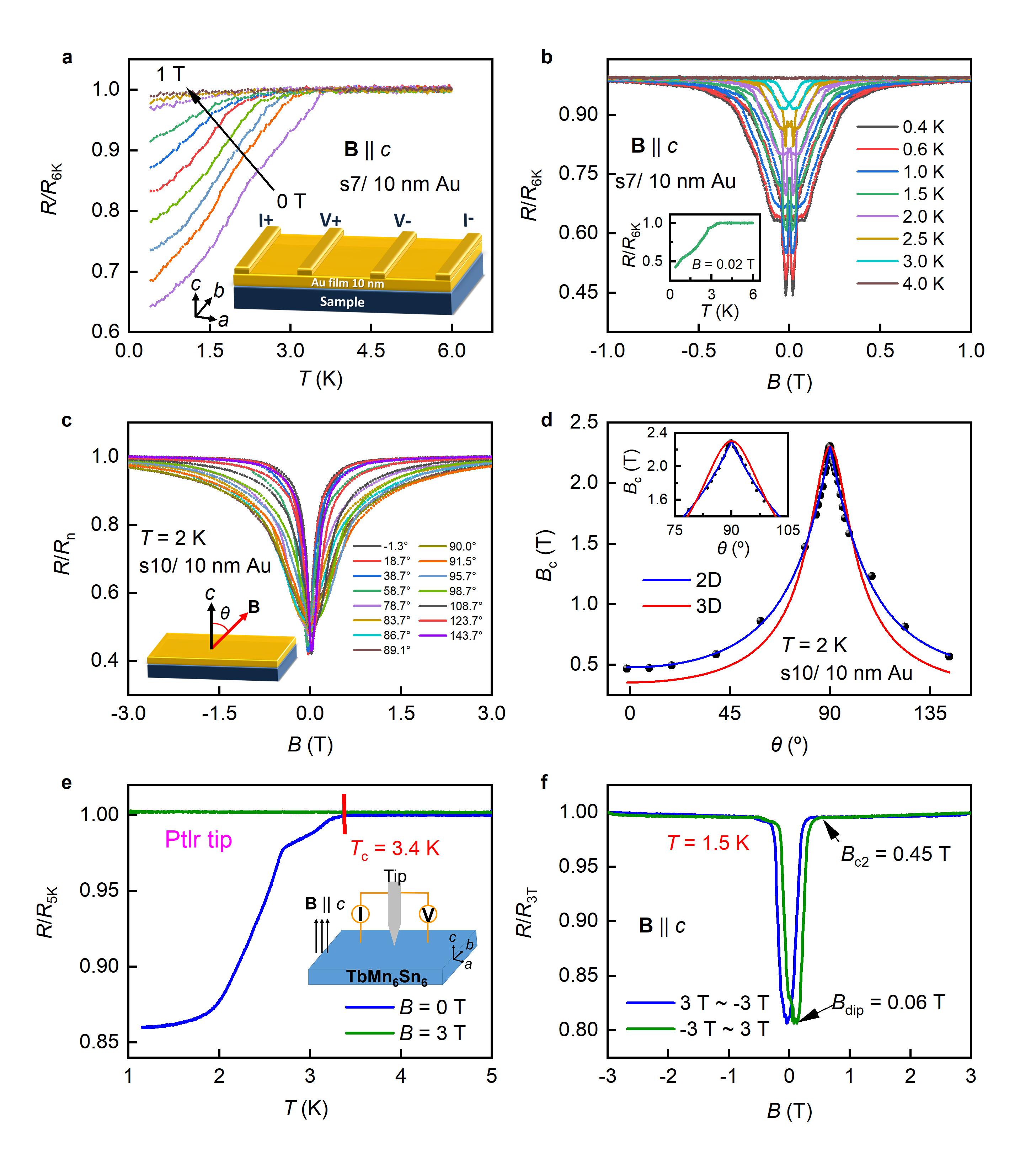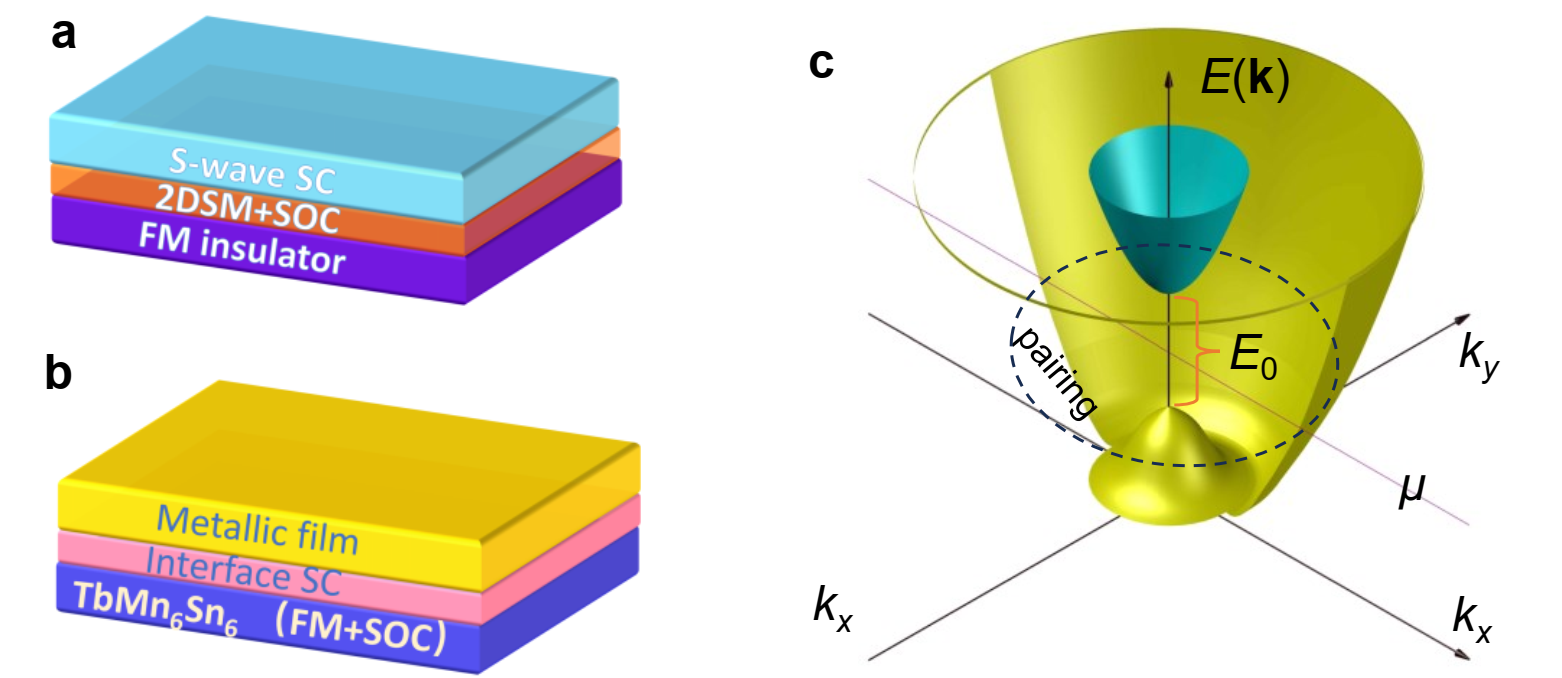In 2016, for the first time, Prof. Jian Wang’s group at Peking University and collaborators reported the observation of superconductivity at the interface between three-dimensional topological Dirac semimetal Cd3As2 crystals and non-superconducting metallic tips. Subsequently, Prof. Jian Wang’s group detected superconductivity at the interfaces between topological Weyl semimetals and non-superconducting metallic tips. Due to the topological non-trivial band structures of topological metals and semimetals, the superconducting states emerging at their surfaces may inherit the topological non-trivial properties and become topological superconducting states, which have important potential applications in topological quantum computing.
Recently, the Kagome magnet TbMn6Sn6 has attracted extensive attention. In TbMn6Sn6, the Kagome lattice formed by Mn atoms has the opposite magnetic moments of Tb atoms along the out-of-plane direction, exhibiting a ferrimagnetic ground state with a Curie temperature of 423 K. Previous theoretical works proposed that in the Kagome lattice, strong spin-orbit coupling and out-of-plane ferromagnetic ordering would generate Chern gapped Dirac fermions, which has been detected by experiments. As a typical magnetic Kagome topological metal, TbMn6Sn6 is non-superconducting.
Recently, Prof. Jian Wang, Prof. X. C. Xie, Prof. Shuang Jia and Prof. Peng Gao at Peking University, in collaboration with Dr. He Wang at Capital Normal University, Prof. Hua Jiang at Soochow University, and Prof. Ziqiang Wang at Boston College, discovered emergent superconductivity at the interface between topological-kagome-magnet TbMn6Sn6 and non-superconducting metal heterostructures. Experimental results indicate that the emergence of superconductivity at the interface is closely related to the ferrimagnetism of TbMn6Sn6, and the superconducting state is quasi-two-dimensional. Taking into account the spin-orbit coupling, the observed interface superconductivity can be a surprising and more realistic realization of the p-wave topological superconductors theoretically proposed for two-dimensional semiconductors proximity-coupled to s-wave superconductors and insulating ferromagnets, providing a new direction for studying spin-triplet pairing and topological superconductivity.
As shown in Fig. 1a, Prof. Jian Wang’s group successfully detected the superconducting signal by depositing non-superconducting metallic thin films on the (001) surface of TbMn6Sn6 samples via interface engineering. The superconducting state emerging on the (001) surface after film deposition shows hysteretic magnetoresistance, indicating that this superconducting state can coexist with ferromagnetism (Fig. 1b). Furthermore, the quasi-two-dimensional superconductivity of TbMn6Sn6/metal heterostructure is revealed by angle-dependent transport experiments(Fig. 1c and 1d). In addition, the emergent superconductivity was also detected in the heterostructures formed by different types of non-superconducting metallic tips and TbMn6Sn6 through point contact spectroscopy (Fig. 1e). Consistent with the TbMn6Sn6/metal film heterostructure, the superconducting state at the point contact also shows the magnetic hysteresis (Fig. 1f).

Figure 1 The emergent superconductivity at the interface of TbMn6Sn6/metal heterostructures. a The evidence of superconductivity for Au film-coated (001) surface of TbMn6Sn6 single-crystal (s7) detected by the standard four-electrode method. The curves are measured at B = 0 T, 0.12 T, 0.145 T, 0.175 T, 0.21 T, 0.25 T, 0.3 T, 0.45 T, 0.7 T, and 1 T, respectively. The magnetic field is applied along the out-of-plane direction (B||c axis). Inset: the schematic of the standard four-electrode measurements for the TbMn6Sn6/Au film sample. b the magnetoresistance measurements of s7 capped with 10 nm Au film at different temperatures (B||c axis). Inset: the temperature dependence of normalized resistance at 0.02 T with a drop down to nearly 40% of R6K. c The angular dependent magnetoresistance curves of a TbMn6Sn6 sample (s10) capped with 10 nm Au film at 2 K. Here θ is the angle between the magnetic field and c-axis of the TbMn6Sn6 sample. Rn is the magnetoresistance at 3 T and B||c axis. d Angular dependence of the critical magnetic field Bc(θ) of s10 capped with 10 nm Au film. Inset shows the zoom-in of the Bc(θ) around 90°, exhibiting that the emergent superconductivity is quasi-two-dimensional. e-f The evidence of superconductivity at the point contact (PC) by pressing PtIr tip onto the (001) surface of TbMn6Sn6. e The temperature dependence of the normalized PC resistance (R/R5K) at zero bias with (green curve, B = 3 T) or without (blue, B = 0 T) applying the magnetic field. Inset: the schematic of the PC configuration, the magnetic field is applied along the out-of-plane direction (B||c axis). f The magnetoresistance measurements of the PC at 1.5 K.
The observation of superconductivity in topological-kagome-magnet/metal heterostructures has important physical significance for studying topological superconductivity. Theoretically, the topological superconductivity can be induced by stacking an s-wave superconductor, a two-dimensional semiconductor with Rashba spin-orbit coupling, and a ferromagnetic insulator to form a heterostructure (Fig. 2a). However, this proposal has not been experimentally realized yet. In this work, these challenges are overcome in the TbMn6Sn6/metal heterostructures (Fig. 2b), since the quasi-two-dimensional superconductivity coupled with the magnetization and strong SOC are all established at the interface, thus providing a more realistic material platform for realizing chiral topological superconductivity (Fig. 2c). Moreover, it is worth mentioning that TbMn6Sn6 is a typical topological magnetic material with a Curie temperature as high as 423 K. Our work is the first report of emergent superconductivity in a material system with a Curie temperature above room temperature.

Figure 2 The theoretical scenario for the interface superconductivity of TbMn6Sn6/metal heterostructure. a The strategy of the proximity-induced topological superconductivity in stacked layers formed by an s-wave superconductor (SC), a 2D semiconductor (2DSM) with Rashba spin-orbit coupling (SOC), and a ferromagnetic (FM) insulator. b The schematic of the detected interface superconductivity in TbMn6Sn6/ metal heterostructures. c The schematic of energy dispersion of interface superconductivity shown in b. E0 is the Zeeman gap. The dashed circle marked by ‘pairing’ indicates the Cooper pairing in the outer band when the chemical potential μ is located in the gap E0.
The paper was published online by Nature Communications on November 2, 2023. Link to the paper: https://www.nature.com/articles/s41467-023-42779-1. Jian Wang and Ziqiang Wang are the corresponding authors. He Wang, Yanzhao Liu, Ming Gong, and Hua Jiang contributed equally to this work. This work was supported by Beijing Natural Science Foundation, National Key Research and Development Program of China, National Natural Science Foundation of China, China Postdoctoral Science Foundation, Capacity Building for Sci-Tech Innovation-Fundamental Scientific Research Funds, U.S. Department of Energy, Basic Energy Sciences, and the Cottrell SEED Award from Research Corporation for Science Advancement.
